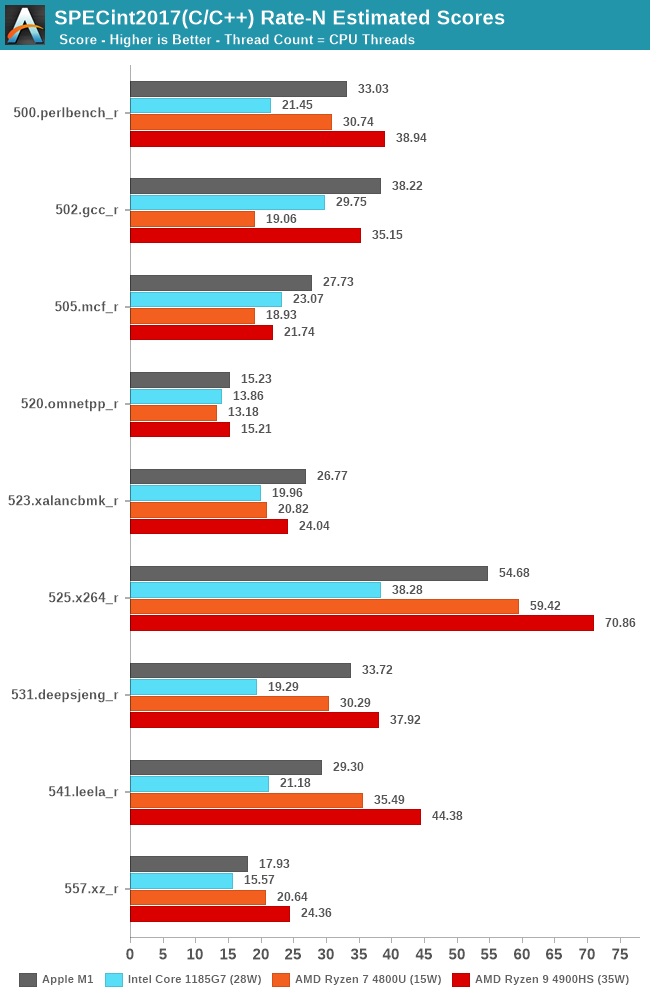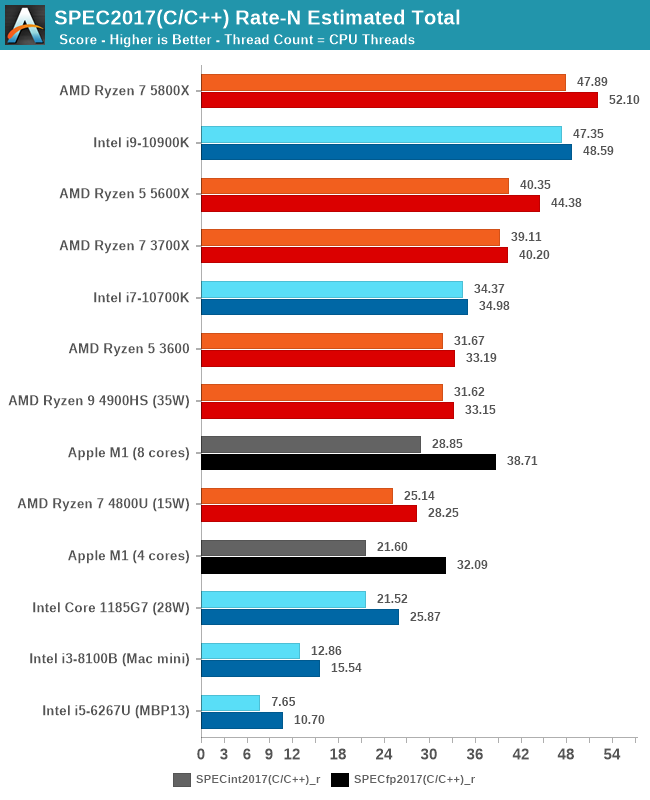The 2020 Mac Mini Unleashed: Putting Apple Silicon M1 To The Test
by Andrei Frumusanu on November 17, 2020 9:00 AM ESTSPEC2017 - Multi-Core Performance
While we knew that the Apple M1 would do extremely well in single-threaded performance, the design’s strengths are also in its power-efficiency which should directly translate to exceptionally good multi-threaded performance in power limited designs. We noted that although Apple doesn’t really publish any TDP figure, we estimate that the M1 here in the Mac mini behaves like a 20-24W TDP chip.
We’re including Intel’s newest Tiger Lake system with an i7-1185G7 at 28W, an AMD Ryzen 7 4800U at 15W, and a Ryzen 9 4900HS at 35W as comparison points. It’s to be noted that the actual power consumption of these devices should exceed that of their advertised TDPs, as it doesn’t account for DRAM or VRMs.

In SPECint2017 rate, the Apple M1 battles with AMD’s chipsets, with the results differing depending on the workload, sometimes winning, sometimes losing.

In the fp2017 rate results, we see similar results, with the Apple M1 battling it out with AMD’s higher-end laptop chip, able to beat the lower TDP part and clearly stay ahead of Intel’s design.

In the overall multi-core scores, the Apple M1 is extremely impressive. On integer workloads, it still seems that AMD’s more recent Renoir-based designs beat the M1 in performance, but only in the integer workloads and at a notably higher TDP and power consumption.
Apple’s lead against Intel’s Tiger Lake SoC at 28W here is indisputable, and shows the reason as to why Apple chose to abandon their long-term silicon partner of 15 years. The M1 not only beats the best Intel has to offer in this market-segment, but does so at less power.
I also included multi-threaded scores of the M1 when ignoring the 4 efficiency cores of the system. Here although it’s an “8-core” design, the heterogeneous nature of the CPUs means that performance is lop-sided towards the big cores. That doesn’t mean that the efficiency cores are absolutely weak: Using them still increases total throughput by 20-33%, depending on the workload, favouring compute-heavy tasks.
Overall, Apple doesn’t just deliver a viable silicon alternative to AMD and Intel, but actually something that’s well outperforms them both in absolute performance as well as power efficiency. Naturally, in higher power-level, higher-core count systems, the M1 can’t keep up to AMD and Intel designs, but that’s something Apple likely will want to address with subsequent designs in that category over the next 2 years.










682 Comments
View All Comments
Alistair - Thursday, November 19, 2020 - link
Yeah I don't want any more CPU cores, I want clock speed increases. I also want double the GPU. M1G with double the GPU, make it happen Apple.ChrisGX - Thursday, November 19, 2020 - link
Long ago, I was in the computer trade, for a time. People, from time to time, still ask me about product purchases and issues of the moment shaping computing products for consumers. From the information already available on the M1 I can say that, at this point, it won't be hard to recommend the MacBook Air (and MacBooks and Mac Minis more generally) to anyone who wants to know what I think. I would mention all the standard caveats, of course. The Apple bear hug is not for everyone but it is hard to miss the fact that Apple is now making better consumer computers than its competitors and, for the first time from any computer products supplier, Apple's computers for average users rate very well on both performance and energy efficiency.As far as I am concerned the Tiger in Tiger Lake turned out to be toothless. Meanwhile AMD has been stung but can't be counted out. If anyone wants to get a computer less expensive than a MacBook Air I would advise and ARM based Chromebook or Tablet.
nicball - Thursday, November 19, 2020 - link
Is it true that the SPEC scores are run in WSL for Windows machines? Then it only makes sense if you compare them among Windows machines, not across OSes.ChrisGX - Thursday, November 19, 2020 - link
Is it true? Hmm...NO!SPEC isn't a secret cabal. You can look this stuff up on their website. Try here:
https://www.spec.org/cpu2017/Docs/system-requireme...
https://www.spec.org/cpu2017/Docs/install-guide-wi...
https://www.spec.org/cpu2017/Docs/
https://www.spec.org/cpu2006/Docs/system-requireme...
https://www.spec.org/cpu2006/Docs/install-guide-wi...
https://www.spec.org/cpu2006/Docs/
substance90 - Thursday, November 19, 2020 - link
The denial of AMD fanboys is so strong.. I can't resist getting the popcorn out.Spunjji - Thursday, November 19, 2020 - link
Yeah, I've been disappointed to see a few familiar names howling with rage at this one.That said, the Intel shills are clearly here too - just under new aliases, as seems to be customary.
vaddieg - Thursday, November 19, 2020 - link
Andrei, why haven't you used 'sudo powermetrics' for chip power introspection? AC Wall measurement doesn't seem to be very accurateSpunjji - Thursday, November 19, 2020 - link
I'd like to see that, too.ricebunny - Thursday, November 19, 2020 - link
Anandtech please clarify which compilers and platforms you are using. I do hope you are using the Intel compiler for Intel chips?The same Tiger Lake chip scored 20% less in this review than it did 2 months ago. This destroys the credibility of your results.
Spunjji - Thursday, November 19, 2020 - link
Only in the SPEC 2017 benches, which they explicitly noted aren't running with the full suite...